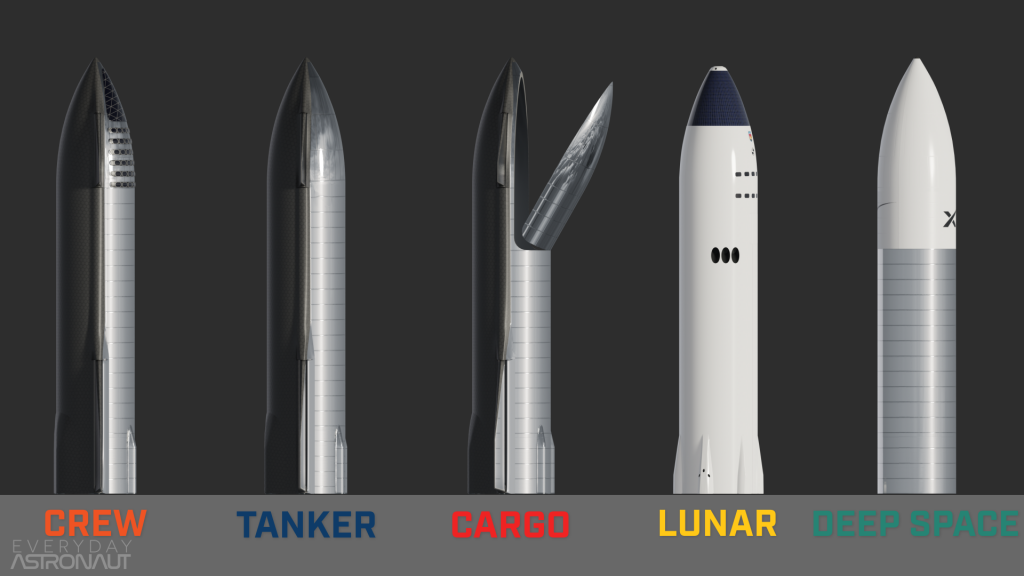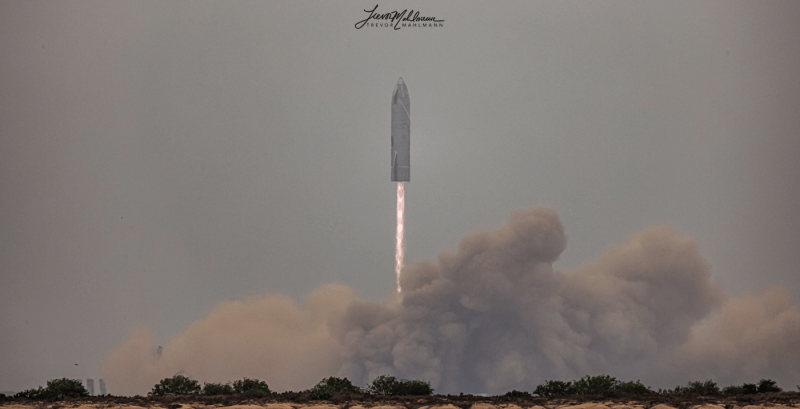Featured image: Trevor Mahlmann
Lift Off Time | May 05, 2021 – 22:24:10 UTC | 17:24:10 CDT |
|---|---|
Mission Name | Medium Altitude Test Flight |
Launch Provider | SpaceX |
Customer | SpaceX |
Rocket | Starship SN15 |
Launch Location | Sub-orbital Test Stand A, Starbase, Texas, United States |
Payload mass | There was no payload on this test flight |
Where did the satellites go? | There was no payload on this test flight |
Did they attempt to recover the first stage? | Yes. However, in the Super Heavy/Starship stack this will be the second stage and will also be recovered. |
Where did the first stage land? | On the edge of the landing pad about 360 meters (~1,000 feet) from Test Stand A, Starbase, Texas, United States |
Did they attempt to recover the fairings? | There are no fairings on Starship |
Were these fairings new? | There are no fairings on Starship |
How was the weather? | Low cloud layer provided minimal visibility. |
This was the: | – 1st successful landing of a Starship prototype – 1st flight of SN15 – 4th flight of a Starship prototype to 10 km – 7th flight of a Starship prototype (excluding three Starhopper hops) – 5th flight of Starship with a nosecone and aerodynamic control surfaces |
Where to watch | Official replay Everyday Astronaut replay Live updates on the exact events leading up to and during launch on launch day |
How did it go?
For the first time ever, SpaceX has successfully landed a Starship prototype on the landing pad approximately 360 meters (~1,000 feet) from the launch mount. SN15 traveled up to an altitude of about 10 km, shutting down each Raptor one by one on ascent. The vehicle then performed the belly flop maneuver as it fell back down towards Earth’s surface. Just above the landing pad, Starship flipped from horizontal to vertical igniting two engines. During its landing burn, the vehicle scrubbed off its remaining vertical velocity and performed a soft touchdown on the pad.

Shortly after landing, there was a small fire coming out from underneath the skirt. The water hoses located at the edges of the landing pad then turned on and extinguished the fire. Shortly after the fire was put out, Starship was safed. This concludes a nominal flight and landing of a Starship prototype for SpaceX.
Starship SN15 Flight Profile
Similarly to the previous prototypes, SN15 flew up to an altitude of around 10 kilometers (~6.2 miles) before performing its belly flop maneuver and falling back down towards the landing pad. Starship intentionally shut down its three Raptor engines during ascent and later reignite them during the flip maneuver. Under the power of its Raptor engines, it flipped from horizontal to vertical on two engines and landed on the landing pad. Below is a table of each event from SN15’s flight.
Events Prior and During Launch
| Event | Description |
|---|---|
| Road Closure | The road leading to the pad and beach closed to all non-SpaceX personnel. |
| Flight Termination System (FTS) Pins Removal | The safety pins were removed which armed the FTS. The FTS is a set of C4 charges that explode the vehicle if it were to go off course or have a malfunction. |
| Pad Clear | Everyone, including SpaceX employees, were cleared from the pad and the surrounding area. |
| Recondenser On (T-00:51:00) | This signified the start of pressurization of tanks on the ground in the tank farm. |
| Ground Tank Clouds (T-00:48:39) | The ground farm became pressurized and prepared to load fuel and oxidizer into the vehicle. |
| LOx and CH4 Tank Load (T-00:37:00) | All four tanks on Starship began receiving their propellants from the ground tanks. This was shown by the frost accumulation on the outside of the vehicle and visible vents. |
| Methane Vent (T-00:24:03) | A vent was seen from the methane tank on Starship, which depressurizes the tank. |
| Engine Chill/Trivent (T-00:12:01) | Engine chill was evident when condensation appeared from inside the skirt, followed by “Tri-vents” or three vents near each respective Raptor engine closer to liftoff. The engines were chilled by liquid oxygen before they ignited. |
| Liftoff! (22:24:10 UTC | 17:24:10 CDT) | The clamps holding down Starship were released after the engines were at desired thrust and the vehicle lifted off from the pad. |
| First Engine Shutdown (T+00:02:07) | On ascent, one engine was shut down intentionally to extend the time they needed to reach apogee in order to maximize the time an engine could fire. |
| Second Engine Shutdown (T+00:03:35) | On ascent, a second engine was shut down intentionally to extend the time they needed to reach apogee in order to maximize the time an engine could fire. |
| Hover and Third Engine Shutdown (T+00:03:59) | At the target altitude, Starship hovered on one engine before initializing the belly flop and shutting it down shortly after. |
| Belly Flop Maneuver (T+00:04:03) | The vehicle used its four aerodynamic fin surfaces (two forward, two aft) to turn belly side down and control its descent as it began to fall back towards the ground. |
| Flip/Engine Relight (T+00:05:42) | At an altitude of approximately 500 meters (~1,600 feet) Starship relit two Raptor engines as the fins and engines forced it to go vertical again. |
| Landing (T+00:06:00) | The engines throttled to decelerate starship at the correct rate as it slowly descended on the landing pad with its landing legs deployed. |
| Depress (T+00:06:01) | After Starship was on the pad, the vehicle began to depressurize by venting as a step toward making the vehicle safe for recovery personnel approach. |
What is Starship?
SpaceX is developing their next generation rocket in Boca Chica, Texas, United States. The launch system consists of the first stage “Super Heavy” vehicle, which will boost the second stage “Starship” out of Earth’s atmosphere. When both are fully stacked, they are referred to as “Starship”. After the two separate, Starship, powered by six Raptor engines, will continue to orbit. This could involve staying in Low Earth Orbit (LEO) or moving on to the Moon and eventually Mars.
As of the development of SN15, four previous Starships have flown with aerodynamic surfaces, (SN8, SN9, SN10, and SN11) with all four exploding before, on, or shortly after landing.

Starship Internals
Starship uses liquid methane (CH4) as its fuel and liquid oxygen (LOx) as its oxidizer. When the vehicle is vertical, the larger liquid oxygen tank is on the bottom and the smaller liquid methane tank is on the top. The reason for the different sizes in tanks is due to the mixture ratio between methane and liquid oxygen that the Raptor engine requires to run properly. However, Raptor can operate outside of this ratio.
At the very top of the vehicle, and in-between the CH4 tank and the LOx tank, are the two header tanks. These tanks are required for the unique flip maneuver that Starship does just before landing on the landing pad. When an engine relights, it must not suck in any gasses. That could result in the loss or damage of an engine. The header tanks are designed to eliminate that, so propellant will always be taken in by the engine while the vehicle is on its side.

Starship Variants
The current Starship launch vehicle is fairly minimal compared to the complex human transport version to be built and flown in the upcoming years. Along with human transportation, Starship also plans to have cargo and tanker versions to perform other various functions.

The crew version of Starship will have the capability to carry humans. The exact number of which is still up for debate, however its capacity will be higher than any other crewed launch vehicle ever built. The tanker appears to be similar to the current version of Starship undergoing testing and development, like SN11. Its main purpose will be to take an extra amount of propellant and transfer it to another Starship already in orbit.
The cargo variant of Starship will carry various types of cargo to a variety of orbits. Current numbers estimate that this variant could take 150 metric tons (330,000 pounds) to Low Earth Orbit (LEO). The lunar and deep space versions are even further out in development but these variants will be able to reach the Moon and the outer planets respectively.
The Raptor Engine
Both Super Heavy and Starship will be powered by various numbers of Raptor engines. The Raptor engines are unique enough themselves and use the Full Flow Staged Combustion Cycle, which makes it one of the most complex engines ever designed and built.

The Raptor engine is still in development, which means that significant and minor changes will occur as the development process continues. One of the more visible changes is the removal of testing hardware which has resulted in the engine plumbing being more compact and streamlined. SN15 was the first Starship to carry these major design changes. As the Raptor engine gets farther along in development and SpaceX gathers more data, more changes will be made.
Future Testing
Up next after the testing of SN15, SN16-20 will begin their line of testing and an orbital flight attempt has been targeted for July of 2021. SN20 is slated to have nearly full heat tiles on the windward side of the vehicle to further test the entry of Starship back into Earth’s atmosphere at 25 times the speed of sound.






I wonder… will SN15 be reused at all for another test or will it be scrapped straightaway? What do you think?
As Tim said yesterday during the stream: “That’s a hard maybe.” Either way would be imaginable.
I think so too. I mean, it is conceivable that there’s no point in scrapping it, but the other way around is also possible.
There’s a point in “scrapping” it. They can analyze the structural integrity now that it has completed the whole maneuver etc.
Wow!! What a wild ride!!!
How is this thing going to land on the uneven surface of the moon or Mars? Seems to need a large level concrete surface. Kind of tall and heavy. What could possibly go wrong?
If you are referring to the landing legs, they kinda suck. Elon has said himself that they will update them in the future. But for now, these will suffice.
There’s no reason to scrap it as it was wired with thousands of strain gauges and other engineering sensors for temperature, vibration, etc. If particular components suffered in-flight stresses beyond acceptable limits can be examined non-destructively via ultrasound, x-ray, dye penetrant, and other techniques. This craft needs to be preserved for its unique accomplishments that are far greater than those for any other aircraft or spacecraft, even the Wright Flyer.
Smithsonian: first craft to ……
Do you know for a fact that it’s “C4”? If not, “explosive charges” would be a better choice. There a other types of explosives; C4 is not generic, even for “plastic” explosives.
The landing legs are self-adjusting and they don’t lock in place until they have all made contact. What we’ve seen aren’t even the final leg design either, just something quick and cheap for disposable prototypes.
As for weight, Starship is under 150 tonnes empty and being tail heavy it has a low centre of gravity. A 100 tonne payload sitting at the top is an issue which is part of the reason it is 9m wide, to give a stable base. Mars only has 1/3 Earth’s gravity so that brings it down to around 80 tonnes fully loaded. The Moon is half of that.
Soft ground is a much bigger problem than unevenness. On Earth a good concrete pad is a necessity but on Mars or the Moon hard ground should be enough.